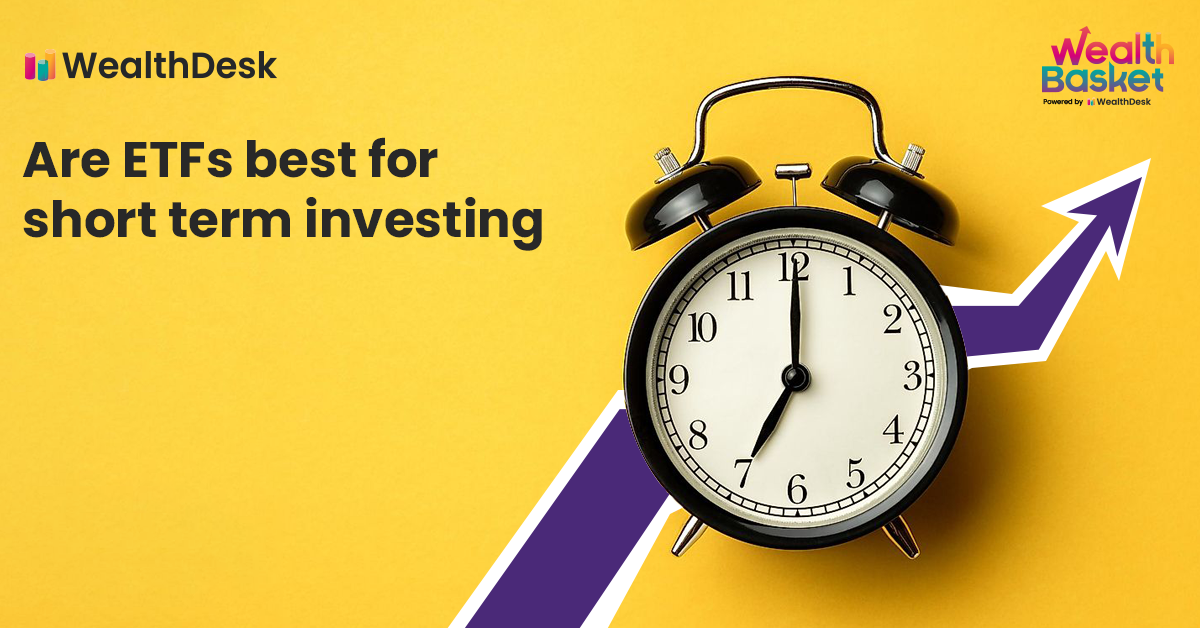As BHARAT Bond ETF gained popularity among investors, many other Asset Management Companies (AMCs), including Axis AMC, IDFC AMC, SBI Mutual Fund, etc., have planned to launch more debt funds in the years to come. The duration for bond ETFs ranges from short, medium to long term; the advantages of investing in short-term bond ETFs and ultra short term bond ETFs are more than the direct bond investments.
This article will explain what short-term bonds are, the best short-term investment options, how ultra-short-term bond ETFs work, and short-term ETF strategies to help you in decision-making.
What are Short-Term Investments?
Short-term investments are those investment instruments that can be converted into cash within five years. In other words, they are marketable securities that can generate short-term returns for your investments that can provide you with liquidity.
Short-term bonds, Bond ETFs, short-term debt funds and FDs with less than five years of maturity are some examples of short-term investment instruments. Since you invest your money in these instruments for the short term, the returns generated by them are not very high. However, specific short-term bond ETFs offer better returns than the other short-term instruments.
Some of the Best ETFs for Short-Term Investment
Short Term Bonds ETFs
One of the best ways to invest your money for short-term growth is investing in short-term bond ETFs. The short-term bond ETFs track a bond index that lists the bonds having one to five years’ duration. They invest in government and corporate bonds with a maturity period ranging from one year to five years.
Ultra Short Term Bonds ETFs
The ultra-short-term bond ETFs invest in the listed bonds index that has a duration of up to one year. It means these are ultra short-term debt ETFs with a return generation capacity within one year, although the return generated on these ETFs would generally be low compared to the other short-term bond ETFs.
As one of the best investment options in India for short-term growth, ultra-short-term bond ETFs usually invest in government bonds maturing within 12 months. These bond ETFs are highly liquid as they can be converted into cash within one year.
Why Should You Consider ETFs for Short-Term Investment?
Debt ETFs are one of the best ways to invest money for short-term because,
- They are highly liquid and can be converted into cash anytime, as they are traded on the stock exchange.
- They offer returns generated by bonds without any lock-in period.
- They track listed bond indexes that mature in a short duration; hence you get the dual benefit of investing in bonds with some features of investing in stock, as these short-term and ultra-short-term bond ETFs are listed on the stock exchange.
- They are well-diversified as they track the bond index consisting of various listed bonds across sectors.
However, short-term investments have the following risks involved:
- They are prone to market volatility risks, as they are listed on the stock exchange.
- They also have underlying asset risks (the risk that the debt securities usually carry). Since bonds carry interest rate risk, liquidity risk, and credit risks, bond ETFs will also have these risks attached to them.
- These ETFs also have tracking error risks, which means that they may not be generating the same returns as the index (that the ETF is tracking) generates.
Short Term ETF Strategies
With the right strategy, you can minimize the risk of investing in short-term ETFs. So, let’s see what can be your short term ETF strategy:
Know Your Asset Under Management (AUM)
After considering your investment goals, risk-taking abilities, and desired asset allocation, you can consider studying various ETFs’ AUM when deciding to invest in a short-term ETF. AUM will help you understand the market size and the fund’s performance you plan to invest in. The higher the AUM of the fund, the higher will be its investor’s size and the trust factor.
Evaluate Cost of Investing
Generally, debt ETFs have a low investment cost compared to debt mutual funds. Similarly, the short-term bond ETFs will also carry costs lower than the direct bond investment. However, you must always consider tax components, risk factors, and other hidden expenses to evaluate the net on-hand returns.
Minimize Tracking Errors
The tracking error refers to the difference between the returns generated by the ETF and the index that it tracks. If tracking errors are more, then the returns will not be as good as its index. The right short-term ETF strategy will minimize the tracking errors.
Closing Thoughts
Short-term bond ETFs have been gaining popularity in India recently, and we will see more of such bond ETFs in the coming years. It is crucial to plan your investment strategies now so that you can invest in the best ETF for short-term growth. At WealthDesk, our SEBI-approved professionals have curated WealthBaskets consisting of stocks and ETFs based on an investment strategy, theme, or idea by following a thought-through market research process.
FAQs
Short-term bond ETFs generate similar returns as the bonds, and since they are traded on the stock exchange, they are more liquid. Hence, they are suitable for short-term investing, but not all short-term ETFs can generate good returns.
Since ETFs track the indexes, they are well-diversified and spread across the sectors; they offer optimized returns. However, they are as volatile to market risks as the stocks are.
ETFs have a low expense ratio of 0.2% per annum compared to mutual funds, which can be ~1% per annum. Hence, ETFs can be an excellent option to invest your money instead of mutual funds.


















